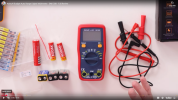Herve QUEVAL
Well-Known Member
Hi Dave, about your questions:
When the board is powered on and I have the mic/line input fader up, #16, I move the 48v phantom power switch off, on, off, on and I get signal bumps on the meter bridge for that input. This appears to be normal. Same result on every mic/line input with 48v power. If the Amp boards are not receiving 48v power, would I still get those signal bumps on the meter bridge?
Normal result because we switch the input load from ground to +48V. Even if +48V is missing, it creates a "pop", especially if +48V is open or show a different impedance than gnd.
If I plug in a run of the mill dynamic mic, (AKG D190ES) the channels all perform normally with good signal output. Does this indicate anything to you?
No, all seems OK on Input side ( except we have no phantom power...).
Need some measurement...
About DeoxIT, I use the products and are very efficient: Contact cleaner product or Fader Lub. It is a good idea to use it especilly when all is open and you can access to the board, fader or contact.
When the board is powered on and I have the mic/line input fader up, #16, I move the 48v phantom power switch off, on, off, on and I get signal bumps on the meter bridge for that input. This appears to be normal. Same result on every mic/line input with 48v power. If the Amp boards are not receiving 48v power, would I still get those signal bumps on the meter bridge?
Normal result because we switch the input load from ground to +48V. Even if +48V is missing, it creates a "pop", especially if +48V is open or show a different impedance than gnd.
If I plug in a run of the mill dynamic mic, (AKG D190ES) the channels all perform normally with good signal output. Does this indicate anything to you?
No, all seems OK on Input side ( except we have no phantom power...).
Need some measurement...
About DeoxIT, I use the products and are very efficient: Contact cleaner product or Fader Lub. It is a good idea to use it especilly when all is open and you can access to the board, fader or contact.


